| View previous topic :: View next topic |
| Author |
Message |
Roger Warin

Joined: 23 Jan 2013
Posts: 1175



|
 Posted: Apr 14, 2013 10:04 Post subject: Olivine twin, a reality? Posted: Apr 14, 2013 10:04 Post subject: Olivine twin, a reality? |
|
|
For some minerals one can find some twins almost never. It’s the case of tourmaline which twin is very rare, and also (even more) of olivine. In the case of olivine, twins have been reported to the microscopic state, because gemologists only observed under optical microscope. It is disturbing that the optical quality of gemstones (peridot).
You should know that in space, some asteroids contain igneous rocks with olivine, pyroxene, etc..
The olivine is in the form of crystalline grains in rocks that have undergone thermal metamorphism, but those who remained in a more primitive state (chondrites), they have retained the original appearance of the crystals. These crystals are included in small silicated droplets called chondrules. We highlighted olivine twins in these aliens crystals.
But in space, these twins olivine are very common. It must of course be a correlation between the physical parameters (particularly temperature and fast kinetics) crystallization BO (barred olivine) chondrules and the appearance of twins.
If this topic interests you, I can develop.
Roger.
|
|
| Back to top |
|
 |
Mark Ost

Joined: 18 Mar 2013
Posts: 516
Location: Virginia Beach



|
 Posted: Apr 14, 2013 12:39 Post subject: Re: Olivine twin, a reality? Posted: Apr 14, 2013 12:39 Post subject: Re: Olivine twin, a reality? |
|
|
| I have a meteorite sample of a Ca poor, diogenite, that may have come from 4 Vesta, an asteroid. The larger asteroids most likely differentiated and incorporate olive in their equivalent of our earth mantle. The beautiful pallasites frequently have crystalline olivine in matrix. The olivine most likely crystallized out of silicate magma. I wonder what the green was in that remarkable meteorite that was displayed a few weeks ago? That was speculated to be from Mercury but there is a problem with the age of the meteorite, being older than Mercury most likely. Either way a beautiful rock. Please feel free to develop. Thanks Roger.
|
|
| Back to top |
|
 |
Roger Warin

Joined: 23 Jan 2013
Posts: 1175



|
 Posted: Apr 14, 2013 14:29 Post subject: Re: Olivine twin, a reality? Posted: Apr 14, 2013 14:29 Post subject: Re: Olivine twin, a reality? |
|
|
Hello Mark,
One may think that this topic is off topic, but in fact, it corresponds to what is happening on Earth at great depths.
Diogenites are plutonic rocks composed mainly of pyroxenes (hypersthene). They were formed on the floor of a magma chamber of Vesta. As a result, the crystals had a slow growth.
As annexes minerals, there are olivine, Ca-pyroxene and plagioclase with anorthite.
Note: closer to the surface of Vesta, eucrites are basaltic Ca- rich achondrites.
I participated in numerous shows in Ste Marie and Munich (29 times in Munich!). Obviously, I was fascinated by minerals, and meteorites seen at the end of 80 's left me unmoved. I fell under their spell when I could understand the study of thin sections of these fabulous rocks.
Here is a picture of a thin section of the meteorite NWA 4473 (diogenite). Most of these crystalline grains are hypersthene (former name of a rock made with orthorhombic pyroxene, and rich in ferrous cations). You can see on the photo an euhedral crystal with a poikilitic inclusion of another pyroxene.
The matrix consists of minute crystals of hypersthene.
The picture is taken in cross-polarized light and the colors are wrong and depend on the refractive indices of minerals and their orientation.
Roger.
| Description: |
Igneous rock: diogenite
(4) Vesta - Asteroids beld |
|
| Viewed: |
17795 Time(s) |
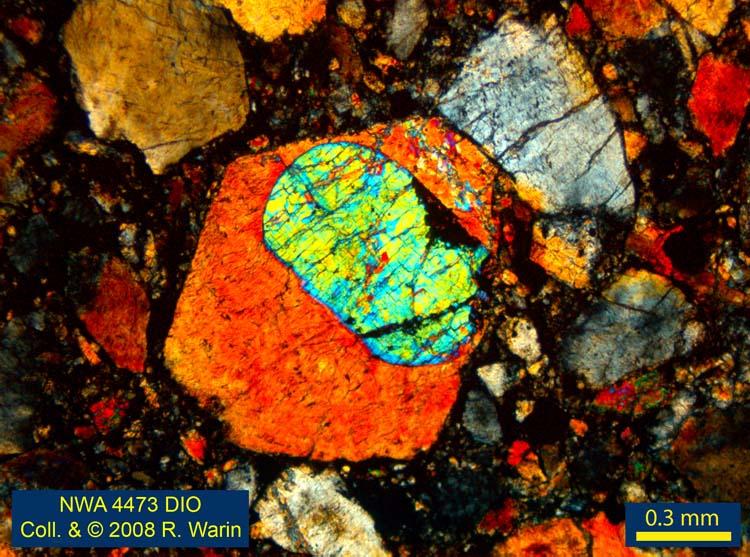
|
|
|
| Back to top |
|
 |
Mark Ost

Joined: 18 Mar 2013
Posts: 516
Location: Virginia Beach



|
 Posted: Apr 14, 2013 14:46 Post subject: Re: Olivine twin, a reality? Posted: Apr 14, 2013 14:46 Post subject: Re: Olivine twin, a reality? |
|
|
| Is that an Augite crystal? Certainly igneous system.
|
|
| Back to top |
|
 |
Mark Ost

Joined: 18 Mar 2013
Posts: 516
Location: Virginia Beach



|
 Posted: Apr 14, 2013 14:49 Post subject: Re: Olivine twin, a reality? Posted: Apr 14, 2013 14:49 Post subject: Re: Olivine twin, a reality? |
|
|
| One of the most fun things I have done was, during a public astronomy session, showing 4 Vesta to the public and then ask if they wanted to hold a piece of it. You can't do that very often. Seems this is sort of a golden age of planetary science. Certainly not off topic. Minerals are minerals!
|
|
| Back to top |
|
 |
Roger Warin

Joined: 23 Jan 2013
Posts: 1175



|
 Posted: Apr 14, 2013 16:36 Post subject: Re: Olivine twin, a reality? Posted: Apr 14, 2013 16:36 Post subject: Re: Olivine twin, a reality? |
|
|
It’s not augite, a monoclinic pyroxene.
Mineral compositions of NWA 4473 DIO: Orthopyroxene compositions fall into at least three distinct populations (median compositions): Fs17.2Wo1.0, FeO/MnO = 34.4; Fs21.6Wo2.1, FeO/MnO = 29.3; Fs37.2Wo3.5, FeO/MnO = 32.6). Olivine (Fa24.5, FeO/MnO = 50.2).
Do you want some explanations?
Roger.
To be followed.
|
|
| Back to top |
|
 |
Mark Ost

Joined: 18 Mar 2013
Posts: 516
Location: Virginia Beach



|
 Posted: Apr 14, 2013 20:01 Post subject: Re: Olivine twin, a reality? Posted: Apr 14, 2013 20:01 Post subject: Re: Olivine twin, a reality? |
|
|
| Sure I'm a life long learner!
|
|
| Back to top |
|
 |
Pete Richards
Site Admin
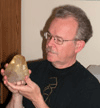
Joined: 29 Dec 2008
Posts: 828
Location: Northeast Ohio



|
 Posted: Apr 14, 2013 20:57 Post subject: Re: Olivine twin, a reality? Posted: Apr 14, 2013 20:57 Post subject: Re: Olivine twin, a reality? |
|
|
| Roger Warin wrote: | For some minerals one can find some twins almost never. It’s the case of tourmaline which twin is very rare, and also (even more) of olivine....
But in space, these twins olivine are very common. It must of course be a correlation between the physical parameters (particularly temperature and fast kinetics) crystallization BO (barred olivine) chondrules and the appearance of twins.
Roger. |
I agree that olivine twins are very rare on earth - I am not aware of any. Can you provide some thin sections and/or other information that supports twinning in extra-terrestrial materials? Is it possible that this is transformation twinning, such as occurs when high quartz reverts to lower-symmetry low quartz?
_________________
Collecting and studying crystals with interesting habits, twinning, and epitaxy |
|
| Back to top |
|
 |
Roger Warin

Joined: 23 Jan 2013
Posts: 1175



|
 Posted: Apr 15, 2013 04:32 Post subject: Re: Olivine twin, a reality? Posted: Apr 15, 2013 04:32 Post subject: Re: Olivine twin, a reality? |
|
|
Before discussing the twin of olivine in some meteorites, I have set an important fact.
Chondrites are made from an accretion of chondrules in a matrix. Chondrules are tiny spherical droplets of silicates. Some are made mainly of olivine. But minor feldspars and other silicates are also present.
It is believed that less than 2 hours, the droplet is cooled and crystallized. It is relatively fast. Under these conditions, olivine grows as skeletal crystals like snow crystals.
Skeletal olivine crystals are strongly different from snow crystals. Olivine crystallizes in a stack of parallel plates. These crystalline wafers reject them all impurities (other silicates like feldspar). These impurities remain in the glassy phase or they may be crystallized in the form of microcrystals.
So an olivine chondrule is as filled parallel planar bars. The whole is enclosed in the microsphere. An envelope surrounding the whole, it is the rim, which can be made of olivine grains or other silicate or even sulfides.
All these bars describe a single crystal. It is built on a single lattice even if spaces filled with impurities separating plates.
This is called an barred olivine chondrule (BO).
During the next message, I will discuss the twin.
Roger.
| Description: |
Barred olivine chondrule
Allende CV3 ox meteorite
Single crystal of olivine ! |
|
| Viewed: |
17666 Time(s) |
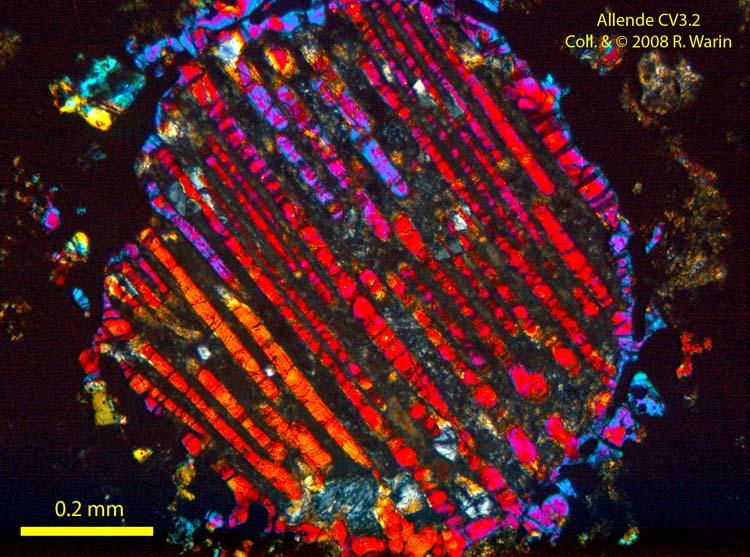
|
| Description: |
Olivine
Allende meteorite
Skeletal crystal and only one lattice |
|
| Viewed: |
17583 Time(s) |
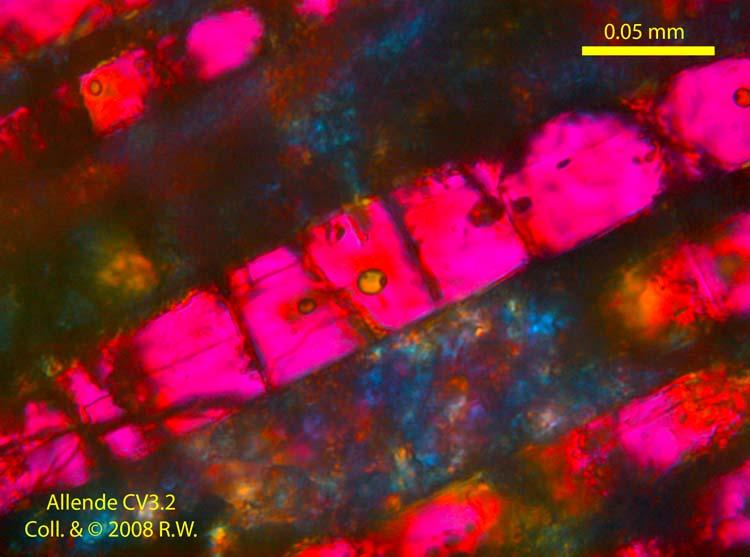
|
|
|
| Back to top |
|
 |
Roger Warin

Joined: 23 Jan 2013
Posts: 1175



|
 Posted: Apr 15, 2013 16:25 Post subject: Re: Olivine twin, a reality? Posted: Apr 15, 2013 16:25 Post subject: Re: Olivine twin, a reality? |
|
|
Pete,
Is it possible that this is transformation twinning, such as occurs when high quartz reverts to lower-symmetry low quartz?
Yes, I think so, and also during the crystallisation.
For Brazil twin, both right and left conformations have the same degree of stability and probability. No structure is privileged. Numbers of left and right crystals are the same. Untwinned quartz under the Brazil law (and even under Dauphine one) are scarce. Automorphs quartz can contain fields of left and right quartz. But it is not always easy to identify this feature. The industrial synthesis of quartz has been developed to avoid mixtures of crystalline phases in a single crystal.
Roger.
|
|
| Back to top |
|
 |
Roger Warin

Joined: 23 Jan 2013
Posts: 1175



|
 Posted: Apr 16, 2013 08:43 Post subject: Re: Olivine twin, a reality? Posted: Apr 16, 2013 08:43 Post subject: Re: Olivine twin, a reality? |
|
|
Olivine twins in meteorites.
Some of BO chondrules can be polysomatic (composed of several bodies, in Greek). This arrangement of groups of bars can be random or can gather fragments of former chondrules. However, quite often, these separate bodies are interconnected by a geometrical reproducible relationship, unbound by chance, but obeying a law of twinning, as they say in crystallography.
Examination of the figure 1 shows what these BO chondrules twinned look like. Typically, a cake was divided into four sectors. When performing the rotation of the thin section, the different sectors of this celestial cake out and light up sequentially. Two diagonals are clear boundaries of each individual of the twin.
It might be a challenge, but it had set the crystallographic axes system from observation of the thin section. This was made possible by Dr. F. Hatert (Univ of Liege) using already old optical techniques in crystallography.
Note that only when the twin is symmetric (regular four sectors) crystallographic axis "a" is approximately perpendicular to the thin section. The axis "c" is parallel to the elongation of the strip of olivine while the axis "b" is perpendicular to the elongation. The unskilled amateur is quickly thrown by this type of language which is an outline of the discussion is summarized in the publication in the “Meteorite” Magazine (University of Arkansas).
If you want to see some additional information, see the web page (in French, but with other sketches).
http':'//www'.'agab'.'be/discussions/Chondre_BO_site'-'2'.'html
Figure 1:
Sequence of alternating extinction of each individual part (Meteorite DaG 412 - CK5) in accordance with rotation of the thin section.
Chondrule width: 1.1 mm. (in a cross-polarized light).
Reproduction autorisée par Robert Beaufort, co-éditeur : Meteorite magazine (University of Arkansas), Nov 2010 Vol 16 No. 4, pp.13-16 de l’article de Roger Warin, Frédéric Hatert and John Kashuba – Hourglass Chondrules.
Roger.
| Description: |
Setting of olivine twin in some chondrite
chondrule, 1.1 mm wide |
|
| Viewed: |
17468 Time(s) |
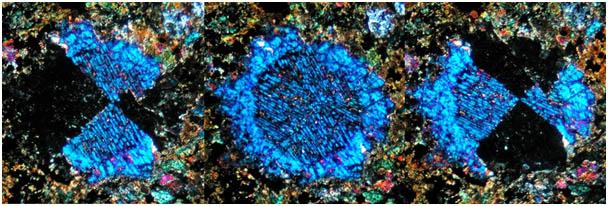
|
|
|
| Back to top |
|
 |
Pete Richards
Site Admin

Joined: 29 Dec 2008
Posts: 828
Location: Northeast Ohio



|
 Posted: Apr 16, 2013 13:48 Post subject: Re: Olivine twin, a reality? Posted: Apr 16, 2013 13:48 Post subject: Re: Olivine twin, a reality? |
|
|
Very interesting, Roger. Now, what is the twin law? It can't be (010) or (001) because those are already mirror planes in the olivine structure. It needs to be of the form (0kl), but I'm not sure how the angle between twin halves relates to the extinction pattern you show. Mindat mentions twinning on {011} and {012}.
_________________
Collecting and studying crystals with interesting habits, twinning, and epitaxy |
|
| Back to top |
|
 |
Roger Warin

Joined: 23 Jan 2013
Posts: 1175



|
 Posted: Apr 16, 2013 16:24 Post subject: Re: Olivine twin, a reality? Posted: Apr 16, 2013 16:24 Post subject: Re: Olivine twin, a reality? |
|
|
Many thanks, Pete.
Twin laws found are (011), (012) and (021).
Roger.
|
|
| Back to top |
|
 |
|


